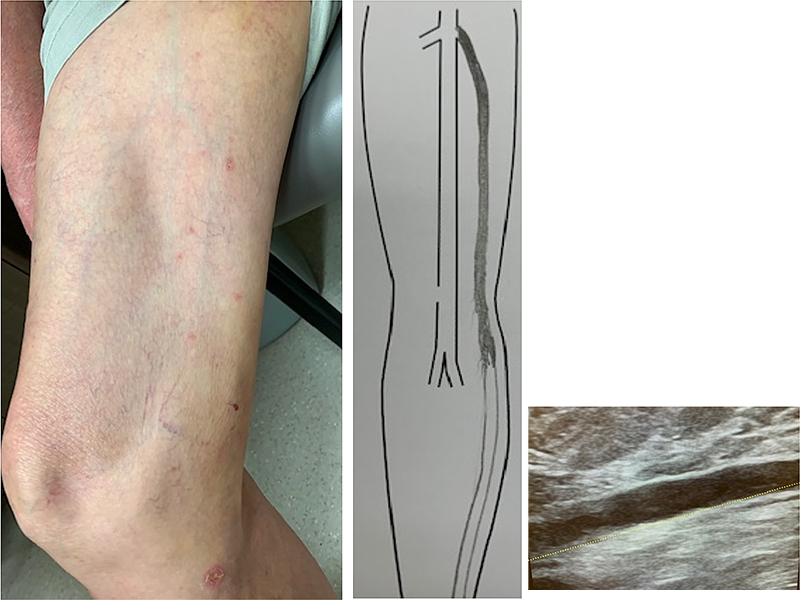Varicose veins treatments have been intrusive, and with a long downtime. Here, DR TANG TJUN YIP and DR JULIAN WONG CHI LEUNG answer questions on the latest approaches to this common condition, and their many advantages.
What exactly are varicose veins?
Varicose veins are abnormal dilated veins, which can be seen bulging on the skin surface of the legs and ankles. They are caused by damaged valves within the veins, which result in blood pooling in the legs, causing the veins to bulge.
Varicose veins have two major components. The first are the obvious lumpy, twisted veins on the surface. These are the “varicose veins” people talk about. The second are the underlying “truncal veins”, which are invisible from the surface but cause most of the problems. They are responsible for swelling of the ankles, cramping of the legs and the red or brown stains around the ankles. Therefore, it is essential to treat these underlying veins first, followed by the lumpy veins on the surface.

Why varicose veins should not be left fester?
Varicose veins are not just a cosmetic problem – they should be treated early because they usually become progressively worse. Varicose veins can lead to other health complications if left untreated, including bleeding, inflammation (phlebitis), blood clots (deep vein thrombosis) and skin issues such as rashes, cellulitis and eczema. The worse complication is venous leg ulcer development, which are wounds that form typically at the level of the ankle and are slow to heal and are prone to recurrence. The good news is that with the right treatment and care, varicose veins and their associated complications can be treated.
How does varicose vein ablation work?
In the past, doctors “stripped” away these underlying “truncal” veins. However, stripping causes most of these veins to grow back again. Currently, the best way to treat the truncal veins is by a minimally invasive or “keyhole” approach called “endovenous ablation”, as recommended by the The National Institute of Health and Care Excellence (NICE) from the UK. “Endovenous” means that the treatment device is inside the vein during the therapy. This is achieved by temporarily delivering an energy device in the form of a catheter (thin plastic tube) under ultrasound guidance, into the truncal vein under the skin surface, usually through a pinprick hole at the knee/calf level.
What are the current options for endovenous ablation?
The two commonest types of “endovenous ablation” are heat-based using either radiofrequency or laser devices, to close the diseased vein permanently. However, radiofrequency ablation requires the catheter to be directly in contact with the vein wall, otherwise suboptimal closure will result. This isn’t necessary for endovenous laser. Laser generates heat to over 900 degree causing potentially more pain and bruising post-operatively.
Endovenous microwave ablation (EMWA) is the latest treatment for leg varicose veins. It uses heat conduction to permanently destroy the refluxing truncal vein. Closing these veins, forces the returning blood from the foot to flow the right way again. Hence patients improve symptomatically almost immediately.

How is EMWA actually performed?
A local anaesthetic is the only sort of numbing agent needed for this procedure. The surgeon uses ultrasound to visualise the target vein. A small needle is pushed through the numb patch into the vein at the knee/calf level. A wire is then passed through the needle. A thin plastic tube (sheath) is passed over the wire and into the vein. This is the entry route for the microwave catheter, which is placed carefully at the correct level within the faulty vein under ultrasound guidance.
The surgeon then injects local anaesthetic around the vein. This stops the heat from damaging nearby structures or the overlying skin. The microwave is turned on and the correct energy level is set. The microwave heat denatures proteins in the vein wall, permanently blocking it. The microwave catheter is pulled back segmentally to block the entire length of the diseased vein and everything is removed at the end of the procedure, with nothing left behind.
Below shows one week post EMWA showing minimal bruising and swelling of the right thigh area. The ultrasound showed that the main vein under the surface of the skin had successfully shut after treatment with no flow of blood demonstrated.

What are the advantages of EMWA?
Microwave has all of the advantages of radiofrequency ablation as well as the latest laser fibres. It does not have to be in direct contact with the vein wall, which is an advantage for the larger diameter veins. The power passes from the side of the tip directly into the vein wall allowing the vein to completely collapse and stay shut. Also it does not emit any wavelength light hence no laser precautions such as a performing the procedure in a laser proof room with eye protection are required. As such, the new microwave treatment for varicose veins (EMWA) appears to have several advantages including more control and refinement over the current available endothermal techniques. Also the majority of the patients treated do not need to wear compression stockings post-operatively, an added advantage in Singapore’s temperate climate.
How many varicose veins treatments are required?
Generally one treatment session is required. This takes approximately 30 minutes. The smaller tributary veins and spider veins, which have not resolved by the initial treatment can be touched up later by one to two sessions of simple injection sclerotherapy, using a very fine needle.
What to expect post-procedure?

Your legs will be bandaged up for 48 hours. You will get up and walk around immediately after the procedure and post-operative pain is usually minimal. You can resume normal activities within 24 hours and be able to go for gentle exercise after the check visit. There is usually only one small puncture, with no large scars.
What the research shows so far for EMWA?
We have performed research to show the optimal settings and technique for using EMWA. The MicrowAvE ablationS for Treatment of vaRicose veins in singapOre (MAESTRO) registry, recently published in the journal of Phlebology, demonstrated that EMWA was a safe and efficacious device associated with a high rate of target vein sealing and sustained quality of life improvement in patients at 12 months. Patients were highly satisfied with the experience and outcome.
The first case of EMWA for varicose veins in Singapore was performed in March 2020 by Dr Tang – with over 100 cases performed subsequently to date. Dr Tang and Dr Wong are both experienced endovenous surgeons and are two of the pioneers using the device in South East Asia. Dr Tang originally learnt the technique at the famous Whiteley Clinic in London, UK, from Professor Mark Whiteley – the first vascular specialist to use microwave ablation to treat varicose veins in the UK. Dr Tang is currently a proctor for EMWA for other vascular specialists in the Asia Pacific region.

Left – Dr TANG Tjun Yip MA (Hon, Cantab), MBBChir, MD (Cambridge), FRCS(Gen), FAMS Medical Director, Senior Consultant General & Vascular Surgeon
Right – Dr Julian WONG Chi Leung MBBS, FRCS (Gen) FRCS (Edin), FAMS Medical Director, Senior Consultant General & Vascular Surgeon
Written in collaboration with The Vascular & Endovascular Clinic
#08-08 Gleneagles Medical Centre, 6 Napier Road
Tel: +65 62527138 | Whatsapp: +65 9173 0272
Email: enquiries@vascularclinic.sg
www.vascularclinic.sg
IG: theveclinic





